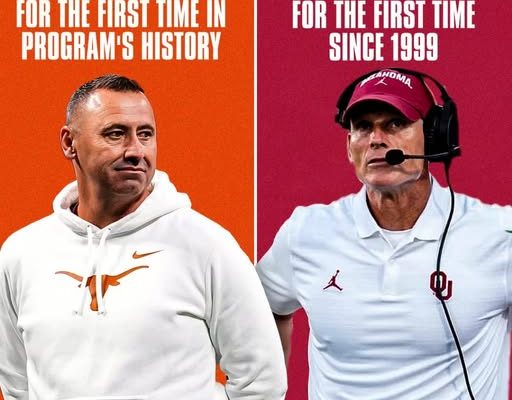The gap between the Texas Longhorns and the Oklahoma Sooners in the preseason poll is undeniably massive, sparking debates among college football fans and analysts alike. As the two historic rivals prepare for another season, the disparity in their preseason rankings raises questions about expectations, roster strength, coaching, and recent performance. While preseason polls are far from definitive, they set the tone for the narrative surrounding teams before a single snap is played. In this case, the Longhorns appear to have garnered significantly more confidence from voters than the Sooners, and the reasons behind this divide are worth exploring.
One of the most obvious factors contributing to Texas’ higher ranking is their recent trajectory under head coach Steve Sarkisian. After years of inconsistency, the Longhorns showed marked improvement last season, culminating in a Big 12 Championship and a College Football Playoff appearance. Though they fell short in the semifinals, the experience gained from playing on such a big stage cannot be understated. Quarterback Quinn Ewers returns with another year of development under his belt, and the addition of standout transfer players has bolstered both the offense and defense. The Longhorns also boast one of the most talented rosters in the country, with elite recruits filling key positions. This combination of experience, talent, and momentum makes Texas a legitimate national title contender in the eyes of many.
On the other hand, Oklahoma finds itself in a transitional phase. The Sooners struggled at times last season, particularly on defense, and while head coach Brent Venables is a respected defensive mind, the unit has yet to fully click. Offensively, Oklahoma lost quarterback Dillon Gabriel to the transfer portal, leaving a question mark at the most important position on the field. While Jackson Arnold, a highly touted recruit, is expected to take over, his lack of experience at the collegiate level introduces uncertainty. The Sooners also face the challenge of adjusting to life in the SEC, a conference known for its brutal week-to-week competition. While Oklahoma has the pedigree and resources to compete at the highest level, the current roster and schedule make it difficult to project them as a top-tier team right now.
Another key difference lies in recruiting and player development. Texas has consistently landed top-five recruiting classes in recent years, translating that talent into on-field production. Players like Ewers, wide receiver Xavier Worthy, and defensive tackle T’Vondre Sweat have lived up to their high school rankings, giving the Longhorns a star-studded lineup. Oklahoma, while still recruiting well, has not quite matched Texas in terms of blue-chip talent over the past few cycles. Additionally, the Longhorns have done a better job retaining key players through the transfer portal era, whereas the Sooners have seen significant turnover.
The coaching stability at Texas also plays a role in the preseason optimism. Sarkisian, once seen as a questionable hire, has silenced critics by building a cohesive program with a clear identity. His offensive system has maximized the talents of his players, and the hiring of defensive coordinator Pete Kwiatkowski has paid dividends. In contrast, Venables is still in the process of establishing his culture at Oklahoma. While he has a strong reputation as a defensive coordinator, turning around a program as a head coach takes time, and the growing pains have been evident.
Of course, preseason polls are not always accurate predictors of success. Injuries, breakout players, and unexpected developments can drastically alter a team’s trajectory. Oklahoma has a history of outperforming preseason expectations, and if Arnold thrives at quarterback and the defense takes a step forward, the Sooners could quickly close the gap with Texas. Conversely, if the Longhorns struggle with the weight of high expectations or suffer key injuries, their lofty ranking could prove premature.
The historical rivalry between these two programs adds another layer of intrigue. Texas and Oklahoma have been battling for supremacy in the Big 12 for decades, and their move to the SEC will only intensify the competition. While Texas may hold the edge in the preseason, the Red River Rivalry has a way of leveling the playing field. When these teams meet in October, rankings and predictions often go out the window, replaced by the sheer intensity of one of college football’s greatest showdowns.
Ultimately, the gap between Texas and Oklahoma in the preseason poll reflects the current state of the two programs. Texas is viewed as a team on the rise, with the talent and coaching to compete for a national championship. Oklahoma, meanwhile, is seen as a program in transition, with potential but also significant question marks. Whether this gap remains throughout the season will depend on how both teams perform when the games begin. One thing is certain: college football is unpredictable, and the only true measure of a team’s worth is what happens on the field.



